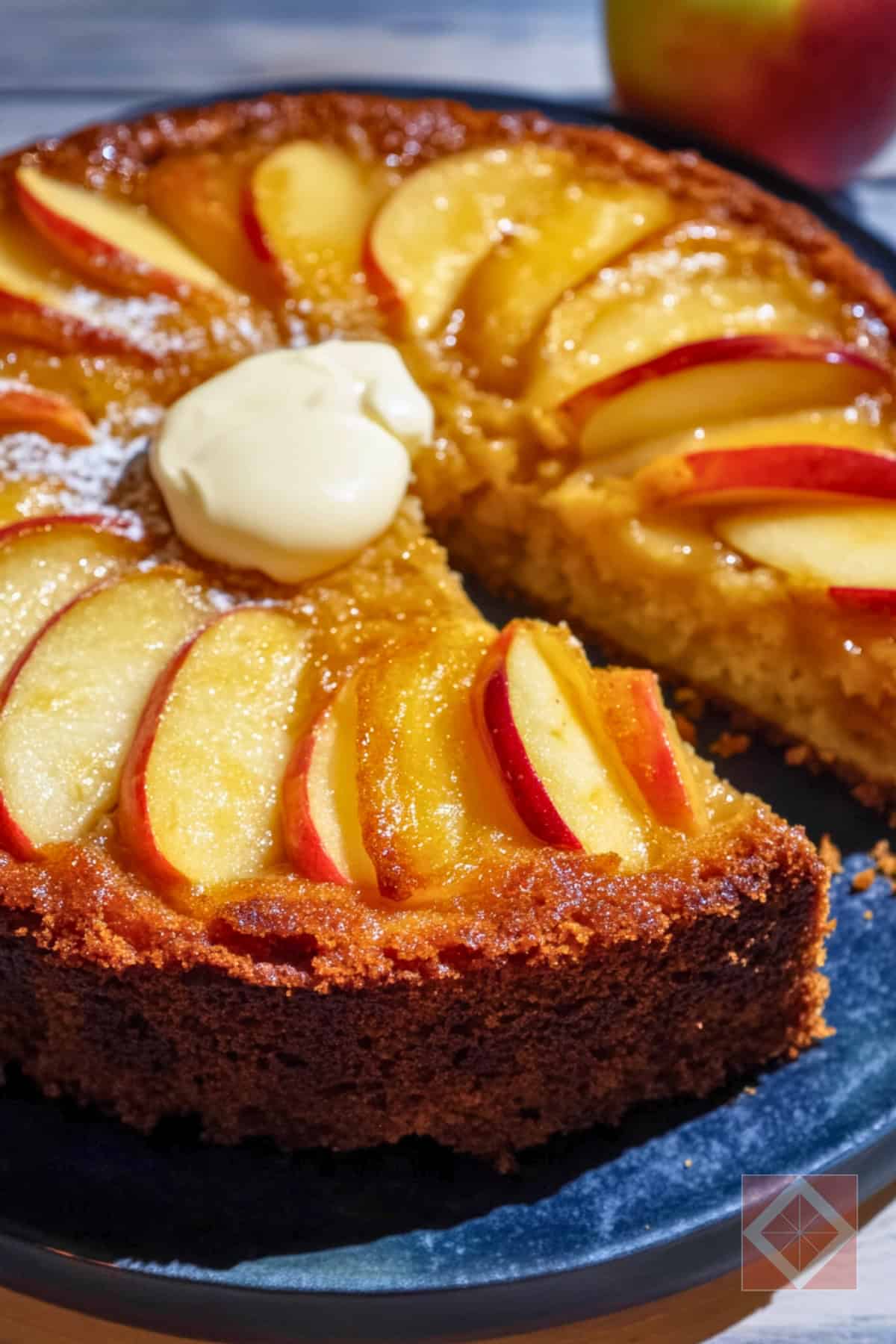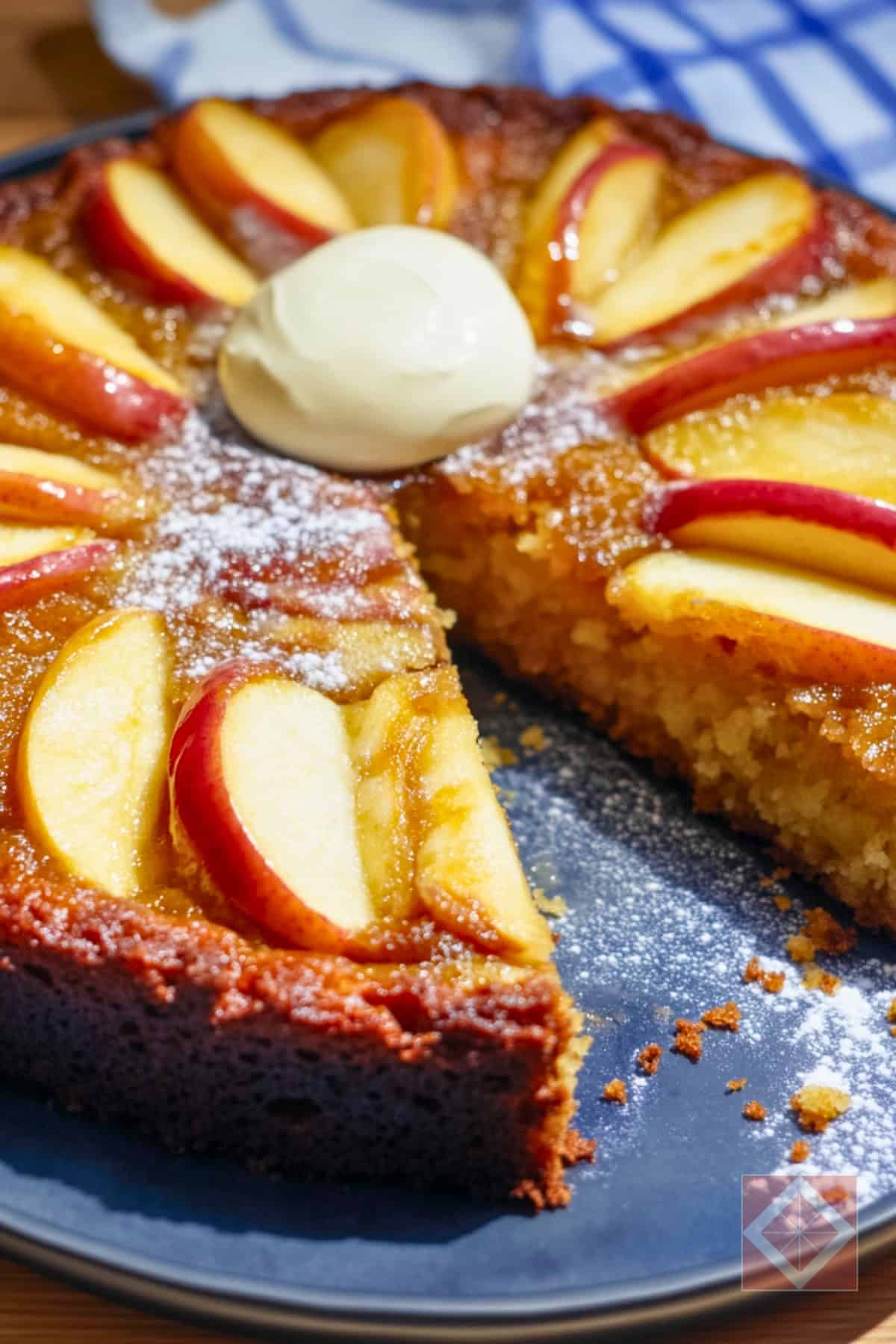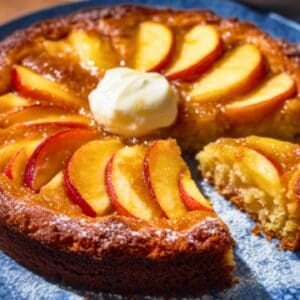The charm of old recipes lies in their ability to transport people back in time with just a single bite. The Dutch Apple Cake, a timeless upside-down cake, is one such nostalgic delight.
While the pineapple version often takes center stage, this lesser-known variation deserves just as much admiration. With caramelized apple slices resting on a spiced, buttery crumb, this dessert embodies the heart of vintage baking traditions.
The Art of the Upside-Down Cake

The concept of flipping a cake after baking may seem modern, but it is far from new. This method was used to create visually appealing desserts with caramelized fruit toppings.
In American kitchens, this technique became more refined, resulting in upside-down cakes that showcased the natural sweetness of fruits like apples, pineapples, and peaches.
Dutch Apple Cake is a prime example of this approach. The preparation starts with a buttery, sugary base that caramelizes as it bakes, turning ordinary apple slices into a golden, glistening layer.
Once flipped onto a plate, the effect is stunning—an inviting mosaic of tender, caramelized fruit sitting atop a soft, spiced cake.
Choosing the Right Apples
The key to a perfect Dutch Apple Cake lies in selecting the right apples. Firm, tart varieties work best, as they hold their shape and balance the sweetness of the caramelized topping. Some of the most recommended apples include:
- Granny Smith – Offers a sharp tartness that contrasts beautifully with the brown sugar glaze.
- Gala – Provides a mild sweetness and a soft texture that blends well with the spiced cake.
- Honeycrisp – A crisp, juicy choice that brings both sweetness and a pleasant bite.
These apples not only enhance the cake’s flavor but also create an eye-catching pattern when arranged carefully in the pan.
Baking Secrets for the Best Texture
While the ingredients in Dutch Apple Cake are simple, achieving the perfect texture requires attention to detail. A few key techniques ensure the cake turns out light, moist, and flavorful:
- Cold butter for a crumbly texture – Cutting cold butter into the flour mixture creates a tender, crumbly consistency, similar to a biscuit or scone.
- Minimal mixing for a light crumb – Overmixing can result in a dense cake. Stirring the batter just until combined ensures a soft texture.
- Proper layering to prevent sogginess – Pressing the apples gently into the sugar and butter mixture allows for even caramelization without excess moisture seeping into the cake.
These techniques have been used in old recipes for generations, proving that sometimes, the simplest methods yield the best results.
Serving & Pairing Ideas
Dutch Apple Cake is best enjoyed warm, fresh out of the oven, when the caramelized topping is at its most decadent. As it cools, the center of the cake becomes even moister, making every bite rich and satisfying. Traditional pairings include:
- Chantilly cream – A lightly sweetened whipped cream that enhances the cake’s airy texture.
- Vanilla ice cream – A classic complement that balances the warmth of the cake with a cool, creamy contrast.
- Spiced tea or coffee – The cake’s cinnamon and nutmeg flavors pair beautifully with warm beverages like chai or dark roast coffee.
These accompaniments highlight the comforting nature of the dish, making it a favorite for family gatherings and cozy afternoons.
A Taste of Nostalgia

Baking Dutch Apple Cake is more than just making dessert—it is a way of preserving history.
Passed down through generations, this cake reflects the simplicity and warmth of home baking traditions. Its origins may date back to the 1920s, but its appeal remains timeless.
Old recipes like this one serve as a delicious reminder that some things never go out of style. With its caramelized apple topping, rich spiced crumb, and comforting flavors, Dutch Apple Cake continues to bring joy to kitchens today, just as it did over a century ago.

Dutch Apple Cake (1920s Old Recipe)
Equipment
- 9-inch cake pan
- Pastry cutter or fork
- Mixing bowls
Ingredients
Bottom Layer:
- 2 tablespoons butter softened
- ½ cup packed dark brown sugar
- ¼ teaspoon grated nutmeg
- 2 cups thinly sliced apples Granny Smith, Gala, or Honeycrisp
Cake:
- 2 cups all-purpose flour
- 1 teaspoon baking soda
- 1 teaspoon salt
- ½ cup granulated sugar
- ¼ teaspoon ground mace or substitute with nutmeg
- ½ teaspoon ground cinnamon
- ½ cup cold butter cut into small cubes
- ¾ cup buttermilk
- 1 large egg
Instructions
Preparing the Bottom Layer:
- Preheat your oven to 375°F.
- Generously coat a 9-inch cake pan with the softened butter. Evenly sprinkle the brown sugar and nutmeg over the bottom of the pan.
- Arrange the sliced apples decoratively over the sugar mixture, ensuring they are evenly distributed.
Making the Cake Batter:
- In a large bowl, whisk together the flour, baking soda, salt, granulated sugar, mace (or nutmeg), and cinnamon.
- Add the cubed cold butter to the dry ingredients. Using a pastry cutter or fork, cut the butter into the flour mixture until it resembles coarse crumbs.
- In a separate bowl, whisk together the buttermilk and egg until well combined. Pour this mixture into the dry ingredients and stir gently until just combined. The batter will be slightly lumpy.
Assembling and Baking:
- Spoon the batter over the arranged apples, spreading it carefully without disturbing the fruit layer. Lightly press down to ensure even distribution.
- Bake for 30 to 35 minutes, or until a toothpick inserted in the center comes out clean and the top turns golden brown.
- Once baked, run a sharp knife along the edges to loosen the cake. Immediately invert onto a serving plate while still warm.
- Serve fresh out of the oven with Chantilly cream or vanilla ice cream for an authentic old-time experience.
Notes
Davin is a jack-of-all-trades but has professional training and experience in various home and garden subjects. He leans on other experts when needed and edits and fact-checks all articles.

